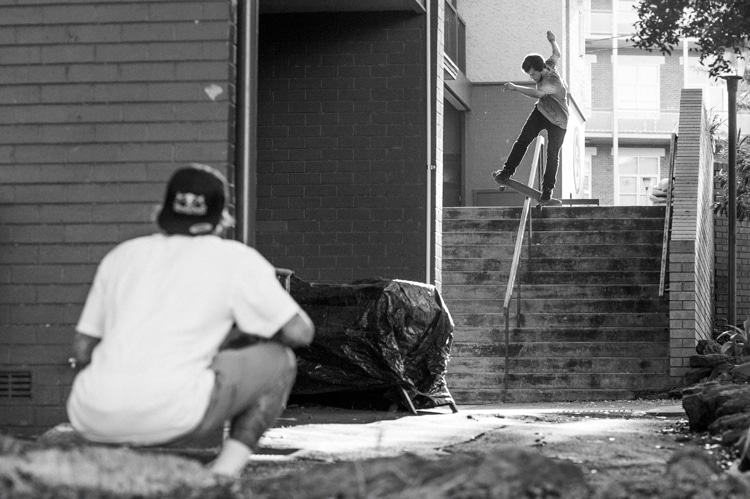The role of a “spotter” in skateboarding is often overlooked, yet their contribution is crucial for both the safety and success of skaters. While the skater performs tricks that grab attention, the spotter is responsible for the behind-the-scenes work that enables those feats. They ensure that the environment is secure, free of potential hazards, and that the skater has the confidence to fully commit to their moves. This dynamic brings to light the importance of trust, awareness, and communication between skater and spotter, building a partnership integral to the skateboarding community.
The Spotter’s Role in the Skateboarding Community
At first glance, it might seem that skateboarding is an individual pursuit, a sport where the skater stands alone against the urban landscape, performing tricks that defy gravity. Yet, this perspective misses a key aspect of the culture: the sense of community, especially the unsung contributions of the spotter. The spotter is much more than a lookout or helper—they are a vital partner who shares responsibility for the skater’s safety and performance.
A spotter watches the surroundings with an almost instinctual focus, scanning for potential obstacles like pedestrians, traffic, or police. This allows the skater to remain concentrated on their trick without worrying about the environment. The spotter’s role requires not only keen awareness but also an intimate understanding of timing and terrain. A misjudgment could lead to serious injury, which is why skaters and spotters often develop a deep sense of trust. In essence, the spotter ensures that the skater’s path remains clear, physically and mentally, allowing for unbroken focus during highly complex maneuvers.
The Psychology of Spotting: Trust and Communication
The connection between a skater and their spotter goes beyond simple logistics. It involves an intricate psychological dance built on trust, responsibility, and unspoken communication. Spotters must anticipate problems before they arise, reading the flow of the street, the movement of people, and the risks that may not be obvious. They must be able to quickly signal to the skater when the coast is clear or, conversely, when they need to abort a trick. These signals, whether verbal or through gestures, are often subtle but incredibly important.
In skateboarding, where the environment can shift unpredictably—whether through weather changes, the arrival of security, or unforeseen obstacles—the spotter’s role in offering real-time updates is essential. Skaters trust their spotters to make quick decisions and relay critical information in moments when reaction times matter. This level of trust is developed over time and often through shared experience. It highlights the role of communication, both spoken and unspoken, in navigating a world that is full of variables and potential hazards.
Spotters as Guardians of Space
One of the more interesting dimensions of a spotter’s role is how they act as “guardians” of skate spaces. Skateboarding often takes place in public or semi-public spaces—urban plazas, parking lots, stair sets, and railings that were not designed with skating in mind. These areas are contested spaces where skaters are often seen as unwelcome or even disruptive. In such environments, spotters function as protectors, not just of the skaters but of the session itself.
Spotters are aware of the need to balance respect for public spaces with the desire to explore them creatively through skating. They take on the task of maintaining good relations with non-skaters, mediating interactions when necessary. When security or police arrive, spotters are often the first to negotiate on behalf of the skater, trying to buy more time or explain the harmless nature of their activities. Their vigilance allows skaters to push their boundaries while minimizing conflict with others who share the space.
The Technical Aspect: Planning and Precision
From a technical perspective, the role of the spotter requires planning and precision. A successful session is not purely about performing tricks but also about finding the right location, navigating logistical challenges, and ensuring everyone remains safe. Spotters are often involved in the pre-session planning, scouting locations, determining potential hazards, and discussing potential exit strategies if the session is interrupted.
Moreover, their role is not simply reactionary. Spotters also help facilitate the mental preparation skaters need before attempting dangerous tricks. Skaters rely on their spotter to confirm that the timing is right, that all conditions are ideal, and that they can proceed without distraction. This level of collaboration can make the difference between a landed trick and a catastrophic fall.
In some cases, spotters are called upon to assist physically. For example, in downhill skating, spotters may use walkie-talkies or even cars to block traffic, ensuring that the skater has a clear path to safely complete their run. This adds another layer of responsibility, where a mistake could have grave consequences. The mental and physical coordination required in such cases adds to the complexity of the role.
The Emotional Support System
Beyond safety and logistics, spotters often provide crucial emotional support. Skateboarding is a mentally demanding activity. It requires not just physical skill but also the courage to repeatedly face failure, injury, and risk. The presence of a trusted spotter can provide the encouragement and reassurance a skater needs to keep pushing forward. In moments of self-doubt, a spotter might remind the skater of past successes, offer words of motivation, or simply be there as a calming presence.
The camaraderie between a skater and their spotter reflects a broader ethos of skate culture: solidarity and mutual support. Skating can be an isolating experience, but the presence of a spotter creates a collaborative dynamic, where both individuals are working together toward a common goal. The spotter’s encouragement can be the psychological lift that allows a skater to break through mental barriers and achieve something they once thought impossible.
The Underappreciated Hero
It’s easy for the spotlight to fall on the skater, the person performing the gravity-defying trick, the one captured in slow-motion videos or photos as they sail through the air. The spotter, meanwhile, remains in the background, often unnoticed. Yet, without the spotter, many of these feats would not be possible. The success of a skater’s session is often a reflection of the spotter’s attentiveness and dedication. They are an underappreciated hero in the skateboarding world, embodying the selflessness and commitment that often defines tight-knit communities.
In some ways, the spotter’s role is akin to that of a producer in a film—working behind the scenes to ensure that everything goes smoothly, that risks are minimized, and that the star performer can shine. Without the spotter’s vigilance, coordination, and support, many tricks would either not be attempted or could end in disaster.
The Evolving Role of the Spotter
As skateboarding continues to grow, the role of the spotter has evolved. With the increasing popularity of street skating, and skate parks filling up with skaters of all levels, the need for spotters has become more widespread. There’s also a growing recognition within the community that spotters play a crucial role, with many skaters now giving shout-outs to their spotters in video parts and interviews.
In some parts of the world, particularly where skateboarding is newer or less culturally integrated, spotters may even take on additional roles as teachers or mentors. They educate newer skaters on the unwritten rules of street skating, helping them understand the risks and how to navigate urban environments safely. In this way, the spotter serves not only the individual skater but also the broader community, ensuring that skateboarding continues to thrive in a safe and respectful manner.
The Heart of the Skateboarding Community
The spotter’s role is vital, a combination of logistics, safety, emotional support, and cultural stewardship. They ensure that skaters can push their limits, innovate, and challenge themselves in environments that can often be unpredictable and dangerous. Without spotters, skateboarding would be far riskier, both physically and socially.
In recognizing the importance of spotters, we also recognize the deeper values that underpin skate culture—collaboration, trust, and mutual respect. The spotter-skater relationship is one of the clearest examples of how skateboarding is more than just an individual pursuit; it’s a communal effort where everyone plays their part to make the session successful. While the skater may land the trick and capture the footage, it’s the spotter who ensures that moment is possible in the first place. Together, they embody the heart and soul of the skateboarding community.
No comments yet.







